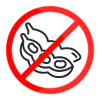










purebulkinc
L-Citrulline DL-Malate (2:1) Powder
Customers Who Bought This Item Also Bought
Supplement Facts & Directions
Supplement Facts
Serving Size: 3000 milligramsServings Per Container: Varies
| Amount Per Serving | % Daily Value* |
|---|---|
| L-Citrulline 2000 mg | † |
| DL-Malic Acid 1000 mg | † |
* Percent Daily Values are based on a 2,000 calorie diet.
† Daily Value Not Established
‡
These supplement facts may vary from the product you receive. Please call for exact numbers.
Other Ingredients: None
Free of: Added Sugar, Soy, Dairy, Yeast, Gluten, Corn & Additives.
Directions: As a dietary supplement, take 3000 mg twice daily or as directed by a physician. An accurate gram weight scale is recommended.
Warning: If you are pregnant, nursing, taking any medications or have any medical condition consult your physician before use. Keep out of reach of children.
Product Details
What is Citrulline Malate?
L-Citrulline DL-Malate, or simply citrulline malate, is a combination of l-citrulline a and malic acid. Descriptions of citrulline have existed since the late 19th century. Citrulline is an amino acid that researchers isolated in a watermelon culture in 1914. They aptly named citrulline after the Latin word for watermelon, Citrullus.
Citrulline fell into obscurity until the early 1930s when researchers discovered citrulline’s involvement in the urea cycle, also known as the ornithine cycle. The body can’t excrete ammonia, a metabolic waste, without first converting it into urea. Synthesizing urea is a complex process that requires carbamoyl phosphate synthetase enzymes to convert ammonia into carbamoyl phosphate before it can enter the urea cycle. Once in the cycle, carbamoyl phosphate donates a phosphate group to ornithine to produce citrulline. The cycle then uses the citrulline to form argininosuccinate, which ultimately produces l-arginine. Arginase enzymes break down the arginine into urea and ornithine. Ornithine translocase delivers the ornithine back to the mitochondria. Thus, the cycle continues while the body excretes urea through the urine.
Citrulline also plays a role in nitric oxide (NO) production. The body uses arginine to synthesize nitric oxide. Citrulline is a byproduct of this process and readily recycles back into arginine.
Malic acid is the predominant acid found in fruit. It is responsible for many of the tart and sour flavors of various fruits. Malate participates in the citric acid cycle, also known as the Krebs cycle or the tricarboxylic acid cycle (TCA). The citric acid cycle is the main pathway for delivering energy throughout the body. The TCA cycle uses malate to produce NADPH. NADPH can then convert into NADH—a primary component involved in producing energy in the form of adenosine triphosphate (ATP).
Potential Citrulline Malate Benefits
Citrulline Malate for Exercise Performance
The combination of citrulline and malate holds promising potential for enhancing exercise performance by boosting energy while also reducing muscle fatigue and soreness. One study found that citrulline malate supplements caused a 34% increase in ATP— the body’s most preferred form of energy. The same study noted a 20% increase in phosphocreatine recovery following exercise. Phosphocreatine recovery is a reliable measure of a muscle’s maximum capacity to use oxygen. Muscles with boosted levels of ATP energy and a higher oxidative capacity are healthier and better able to perform. Another study reported that participants taking citrulline malate were able to increase upper body exercise repetitions by 53% compared to participants taking a placebo.
What does 2:1 Mean?
The 2:1 indicates the ratio of l-citrulline to DL-malic acid. PureBulk’s L-Citrulline DL-Malate (2:1) Powder is two parts citrulline combined with one part malic acid. A larger ratio of citrulline to malic acid delivers the most potent results. However, individuals can experience benefits as long as the malic acid doesn’t exceed the citrulline content.Delaying muscle fatigue allows individuals to exercise for longer, but working a muscle harder than usual typically results in more intense soreness during recovery. Numerous studies confirm that citrulline malate helps relieve sore muscles and expedites muscle recovery after intense exercise. Citrulline’s involvement in the urea cycle may contribute to its ability to reduce muscle soreness, as it removes ammonia waste from muscles while boosting NO production. One study observed that participants’ muscle soreness was 40% less in the first 48 hours after working out if they took citrulline malate prior to exercising. More energy to work out harder for longer combined with less soreness allows individuals to decrease their recovery time between workouts, meaning they can experience significant muscle gains more quickly.
Citrulline Malate and Nitric Oxide
Citrulline exerts vasodilation effects by boosting arginine levels and NO synthesis. It widens blood vessels and improves blood flow by increasing NO production. Vasodilation dramatically enhances the body’s ability to deliver nutrients and oxygen to muscles performing strenuous exercise. It also provides similar benefits by delivering nutrients to help muscles rebuild and recover from exercise faster. One limiting factor is that the body breaks down nitric oxide quickly. One study noted that taking citrulline with reduced glutathione (GSH) hinders this breakdown and boosts nitric oxide levels. More NO also allows the body to use other amino acids more efficiently—particularly branched-chain amino acids (BCAAs) and creatine. Both BCAAs and creatine promote lean muscle growth.
L-Citrulline vs. Citrulline Malate
Bonding malic acid to L-Citrulline builds upon citrulline’s ability to improve NO levels and eliminate waste from muscles by boosting cellular energy and managing post-workout soreness—often referred to as DOMS (delayed onset muscle soreness). Malic acid also improves the body’s ability to absorb and use citrulline.
Potential Citrulline Malate Side Effects
Most individuals tolerate citrulline malate well, as l-citrulline is an important amino acid the body needs for the urea cycle, and malate occurs naturally in many fruits. Some individuals may experience an upset stomach. Citrulline malate may interact with drugs that affect blood flow, such as those used to manage high blood pressure, erectile dysfunction, and some heart conditions. Individuals taking these medications should consult with a physician before taking citrulline malate.
References
- https://www.ncbi.nlm.nih.gov/pubmed/22642880
- https://www.ncbi.nlm.nih.gov/pubmed/1820054
- https://www.ncbi.nlm.nih.gov/pubmed/7858967
- https://archive.org/details/lehningerprincip01lehn
- http://www.sciencedirect.com/science/article/pii/S0065242314000031
- https://pubmed.ncbi.nlm.nih.gov/9686345/
- https://www.uniprot.org/uniprot/P29477
- https://pubmed.ncbi.nlm.nih.gov/24068518
- https://www.sciencedirect.com/science/article/pii/B9780123864567019122
- https://pubmed.ncbi.nlm.nih.gov/10368368/
- https://bjsm.bmj.com/content/36/4/282.citation-tools
- https://www.ncbi.nlm.nih.gov/pubmed/20386132
- https://pubmed.ncbi.nlm.nih.gov/30895562/
- https://pubmed.ncbi.nlm.nih.gov/21067832/
- https://www.ncbi.nlm.nih.gov/pmc/articles/PMC4472409/
- https://purebulk.com/products/glutathione-reduced
- https://pubmed.ncbi.nlm.nih.gov/20499249/
- https://www.ncbi.nlm.nih.gov/pubmed/25226311
Tested by Accredited 3rd Party Labs
PureBulk's supplements are tested by accredited third party labs in the USA to ensure their identity, purity and potency. To receive a copy of these test results or any other PureBulk supplement please fill out the COA request form found here.
*NOTE: These statements have not been evaluated by the Food and Drug Administration. This product is not intended to diagnose, treat, cure or prevent any disease.
Tested by Accredited 3rd Party Labs
PureBulk's supplements are tested by accredited third party labs in the USA to ensure their identity, purity and potency. To receive a copy of these test results or any other PureBulk supplement please fill out the COA request form.

















